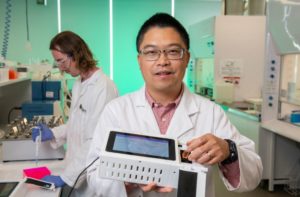People often do not realise they have kidney disease which can lead to long-term health problems. Graphic courtesy Getty Images.
Development of a new way to accurately measure human serum albumin (HSA) levels in people with chronic kidney disease has progressed in recent testing by Flinders University and Japanese researchers.
Further engineering of the novel system of AIE biosensors, pioneered at Flinders University, was conduced by PhD candidate Qi Hu in Japan as part of a National Institute for Materials Science (NIMS) Cooperative Graduate Program, with Dr Masanobu Iwanaga, an expert on metasurface in optical biosensing.
The research project combines fluorescent (FL) biosensors with an aggregation induced emissions (AIE) with further engineering of a novel metasurface platform to improve readings of HSA in urine tests.
“The novel nanophotonic all-dielectric metasurface platform incorporating with AIE biosensors has been fabricated to achieve extraordinary HSA detection performance,” says Professor Tang, adding its potential for testing diabetic kidney disease and acute kidney injury.
More accurate, portable and affordable testing can make large-scale surveys of biomarkers of kidney function more accessible – including in remote or areas with basic health facilities – with chronic kidney disease under-reported in the population because it is often asymptomatic, researchers say.
Biomarker diagnosis can be difficult as the kidneys are still able to function adequately when they are slightly damaged. Low levels of HSA are important indicators to monitor the status or progression of the condition in existing CKD and diabetic kidney disease (DKD) patients. Accurate estimates of the prevalence of all three kidney conditions require large-scale surveys of biomarkers of kidney function in the population.
As some diagnoses require the presence of measured biomarkers that persist for at least three months, people often do not realise they have the disease which can lead to long-term health problems.
Mr Hu says the new platform “integrates a microfluidic system and a metasurface substrate to enable analyte delivery and the monitoring/detecting AIE FL enhancement in real time with the outstanding characteristics of high throughput, good reusability and low reagent consumption.”
Dr Iwanaga, Group Leader of Nanophotonics Group, Research Center for Electronic and Optical Materials at NIMS in Japan, says: “As well, this proposed metasurface can service as a biomedical chip-based platform for providing a promising pathway of enhancing sensing and biomarker detection quantitatively.”
Acknowledgements: This research was supported by the Flinders University – NIMS Cooperative Graduate Program, NIMS Biomaterials and JSPS KAKAENHI Grant Number JP24K01389, the Advanced Research Infrastructure for Materials and Nanotechnology (ARIM) of the MEXT, Japan and the supercomputing resources in the Cyberscience Centre, Tohoku University, Japan. The authors also thank AIEgen Biotech Co Ltd (Hong Kong).

